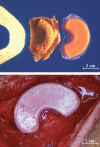Engineering clinically relevant volumes of vascularized bone
- PMID: 25877690
- PMCID: PMC4420594
- DOI: 10.1111/jcmm.12569
Engineering clinically relevant volumes of vascularized bone
Abstract
Vascularization remains one of the most important challenges that must be overcome for tissue engineering to be consistently implemented for reconstruction of large volume bone defects. An extensive vascular network is needed for transport of nutrients, waste and progenitor cells required for remodelling and repair. A variety of tissue engineering strategies have been investigated in an attempt to vascularize tissues, including those applying cells, soluble factor delivery strategies, novel design and optimization of bio-active materials, vascular assembly pre-implantation and surgical techniques. However, many of these strategies face substantial barriers that must be overcome prior to their ultimate translation into clinical application. In this review recent progress in engineering vascularized bone will be presented with an emphasis on clinical feasibility.
Keywords: bone tissue engineering; clinical applications; vascularization.
© 2015 The Authors. Journal of Cellular and Molecular Medicine published by John Wiley & Sons Ltd and Foundation for Cellular and Molecular Medicine.
Figures



Similar articles
-
Engineering Pre-vascularized Scaffolds for Bone Regeneration.Adv Exp Med Biol. 2015;881:79-94. doi: 10.1007/978-3-319-22345-2_5. Adv Exp Med Biol. 2015. PMID: 26545745 Review.
-
[Progress on strategies to promote vascularization in bone tissue engineering].Zhongguo Gu Shang. 2015 Apr;28(4):383-8. Zhongguo Gu Shang. 2015. PMID: 26072627 Review. Chinese.
-
Overcoming physical constraints in bone engineering: 'the importance of being vascularized'.J Biomater Appl. 2016 Feb;30(7):940-51. doi: 10.1177/0885328215616749. Epub 2015 Dec 1. J Biomater Appl. 2016. PMID: 26637441 Review.
-
A novel porous bioceramics scaffold by accumulating hydroxyapatite spherulites for large bone tissue engineering in vivo. II. Construct large volume of bone grafts.J Biomed Mater Res A. 2014 Aug;102(8):2491-501. doi: 10.1002/jbm.a.34919. Epub 2013 Aug 27. J Biomed Mater Res A. 2014. PMID: 23946164
-
Scaffolds for vascularized bone regeneration: advances and challenges.Expert Rev Med Devices. 2012 Sep;9(5):457-60. doi: 10.1586/erd.12.49. Expert Rev Med Devices. 2012. PMID: 23116071 Review. No abstract available.
Cited by
-
Prefabrication of axially vascularized bone by combining β-tricalciumphosphate, arteriovenous loop, and cell sheet technique.Tissue Eng Regen Med. 2016 Oct 20;13(5):579-584. doi: 10.1007/s13770-016-9095-0. eCollection 2016 Oct. Tissue Eng Regen Med. 2016. PMID: 30603439 Free PMC article.
-
Encapsulation of Rat Bone Marrow Derived Mesenchymal Stem Cells in Alginate Dialdehyde/Gelatin Microbeads with and without Nanoscaled Bioactive Glass for In Vivo Bone Tissue Engineering.Materials (Basel). 2018 Oct 1;11(10):1880. doi: 10.3390/ma11101880. Materials (Basel). 2018. PMID: 30275427 Free PMC article.
-
Hierarchical Fabrication of Engineered Vascularized Bone Biphasic Constructs via Dual 3D Bioprinting: Integrating Regional Bioactive Factors into Architectural Design.Adv Healthc Mater. 2016 Sep;5(17):2174-81. doi: 10.1002/adhm.201600505. Epub 2016 Jul 7. Adv Healthc Mater. 2016. PMID: 27383032 Free PMC article.
-
Quantifying Vascular Changes Surrounding Bone Regeneration in a Porcine Mandibular Defect Using Computed Tomography.Tissue Eng Part C Methods. 2019 Dec;25(12):721-731. doi: 10.1089/ten.tec.2019.0205. Tissue Eng Part C Methods. 2019. PMID: 31850839 Free PMC article.
-
Effect of prevascularization on in vivo vascularization of poly(propylene fumarate)/fibrin scaffolds.Biomaterials. 2016 Jan;77:255-66. doi: 10.1016/j.biomaterials.2015.10.026. Epub 2015 Oct 22. Biomaterials. 2016. PMID: 26606451 Free PMC article.
References
-
- Santos MI, Reis RL. Vascularization in bone tissue engineering: physiology, current strategies, major hurdles and future challenges. Macromol Biosci. 2010;10:12–27. - PubMed
-
- Kanczler JM, Oreffo RO. Osteogenesis and angiogenesis: the potential for engineering bone. Eur Cell Mater. 2008;15:100–14. - PubMed
Publication types
MeSH terms
Substances
Grants and funding
LinkOut - more resources
Full Text Sources
Other Literature Sources

